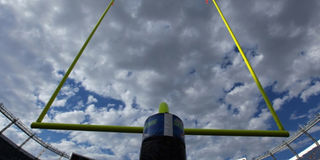Little league football linked to mood problems later: study

Taking up American football before the age of 12 may have an impact on behaviour and mood much later in life, a study of former players said Tuesday. PHOTO| FILE| NATION MEDIA GROUP
What you need to know:
- Those who started the sport early were at higher risk by age 51 to suffer from depression, apathy or other behavioural problems, though memory and thinking skills did not seem to be affected, according to a paper in the journal Translational Psychiatry.
- Repetitive concussive brain injury might have happened in these American football players, but does not provide any evidence for this suggestion.
- By the authors' own analysis, the findings "should not be used to inform safety and/or policy decisions in regards to youth football", and more studies are needed.
Taking up American football before the age of 12 may have an impact on behaviour and mood much later in life, a study of former players said Tuesday.
Those who started the sport early were at higher risk by age 51 to suffer from depression, apathy or other behavioural problems, though memory and thinking skills did not seem to be affected, according to a paper in the journal Translational Psychiatry.
"Youth exposure to football may have long-term neuro-behavioural consequences," it said.
But the study authors could not state conclusively that repeated hits to the head were the cause of any "dysfunction" observed in former gridiron players in later years.
They urged further research "to inform policy and safety decision-making".
Other experts, too, cautioned against reading too much into the study, which involved no examination of former players' brains, and relied on answers to questions by telephone and online, rather than a formal diagnosis.
"The paper hints... that repetitive concussive brain injury might have happened in these American football players, but does not provide any evidence for this suggestion," said Michael Swash, a neurology expert from Barts and the London School of Medicine.
The researcher team, from the United States, used data from 214 former amateur and professional American football players enrolled in an ongoing study of neurodegenerative disease.
The male subjects had not played any contact sport other than football, either at high school, college or professionally.
The study sought to examine potential long-term harms of early exposure to a sport that sees players receive violent head blows that can cause a concussion, linked to later brain problems.
TO PLAY, OR NOT TO PLAY?
The researchers had theorised that the damage may be compounded by starting at an early age.
"Youth football is played between ages of five and 14, a period when the brain undergoes substantial maturation in males," the team wrote.
Young players can experience more than 200 head impacts per season, they added, citing earlier research.
"The effects of repetitive head impact exposure on the brain at a young age may disrupt neurodevelopment," the researchers said.
For the study, former players with an average age of 51 were asked to rate their behaviour, mood, and executive function - which includes tasks like analysing, planning and organising.
They also underwent a test of cognitive ability.
Among those who reported a learning disability, having taken medication for depression, or to have received a psychiatric diagnosis, most had started football when they were younger than 12, said the study authors.
The study did not consider whether the former players had received any head injuries.
By the authors' own analysis, the findings "should not be used to inform safety and/or policy decisions in regards to youth football", and more studies are needed.
David Reynolds, the chief scientific officer of Alzheimer's Research UK, pointed out that sports like American football can contribute to a healthy, active lifestyle.
"It is important that findings highlighting the potential risks of any sport are followed up with further research so that people can make informed decisions about the activities they get involved in and how best to minimise any risks," he wrote in a comment distributed by the Science Media Centre.
In April last year, a study said some 43 percent of retired American football players studied show signs of traumatic brain injury.
The National Football League has faced growing scrutiny in recent years over concussions and head trauma in America's most popular sport.
In 2015, the league agreed to a $1-billion (800-million-euro) settlement to resolve thousands of lawsuits by former players suffering neurological problems.





